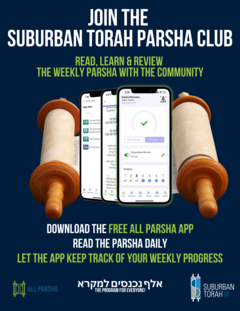"The crown of Torah is ready and waiting for all ... all who want are invited to come and take a share."
Rambam, Talmud Torah 3:1
 The Torah is the underlying foundation that binds us together and makes us who we are as Klal Yisrael, as Rav Saadia Gaon states that "Our nation is a nation because of the Torah”. We must therefore endeavor to connect ourselves to it as best we can. To become truly connected to the whole Torah, we have to read it, learn it, know what it says and spend time trying to understand it. It is in this way that we can embed the lessons, values, and principles of the Torah deep into our consciousness.
The Torah is the underlying foundation that binds us together and makes us who we are as Klal Yisrael, as Rav Saadia Gaon states that "Our nation is a nation because of the Torah”. We must therefore endeavor to connect ourselves to it as best we can. To become truly connected to the whole Torah, we have to read it, learn it, know what it says and spend time trying to understand it. It is in this way that we can embed the lessons, values, and principles of the Torah deep into our consciousness.
For generations we have been called ‘The People of the Book’, but when was the last time we dedicated time to actually reading it?
We have all read or studied parts of it. We have all heard other people read it.
Now it is time to commit, as a community, to spending time each week exploring the rich text that makes up the Written Torah.
By joining the Suburban Torah Parsha Club, all members commit to reviewing the weekly Parsha in one of the following ways:
-
Read the entire Parsha in English.
-
Read the entire Parsha in Hebrew.
-
Read the entire Parsha in both English and Hebrew.
-
Read the Parsha together with Rashi (in any language).
-
Fulfill the Mitzvah of Shnayim Mikra v’echad Targum (Full explanation below).
For all those Parsha Club members who complete Sefer Bereishit there will be a celebratory siyum.
To join the Suburban Torah Parsha Club complete the form below.
Introduction to Shnayim Mikra v'echad Targum
WHAT IS SHNAYIM MIKRA V'ECHAD TARGUM?
The Gemara in Brachos (8a-b) tells us that a person should always complete the weekly Torah portion along with the community, twice in the original Hebrew text (“shnayim mikra”) and once in the Aramaic translation of Onkelos (“echad targum”). The reason given for the practice is that one who completes the Torah reading with the community will be rewarded by having his days and years extended. This was subsequently codified in Halacha by the Shulchan Aruch in the section dealing with Hilchos Shabbos (Orach Chaim 285).
What are the laws of Shnayim Mikra v’Echad Targum?
The laws of Shnayim Mikra v’Echad Targum as recorded in Shulchan Aruch are actually brief enough that we can encapsulate them here:
- Even though a person hears the public Torah reading each week, one must also review the parsha twice in the original Hebrew and once in the Targum Onkelos. This includes even proper nouns like the names of cities.
- The commentary of Rashi may be reviewed instead of the Targum, though the best practice would be to review both Rashi and the Targum;
- Reviewing the weekly Torah portion “with the community” means starting on Sunday;
- The optimum way to fulfill the obligation of Shnayim Mikra v’Echad Targum is to complete the reading before dinner on Friday night. Barring that, one should do so by mincha on Shabbos. Some say that one has until Wednesday of the following week, while others say that one has until Shemini Atzeres. (The Rema explains that Shemini Atzeres – by which we mean Simchas Torah – is when one completes the Torah with the community);
- Shnayim Mikra v’Echad Targum may be performed during the public Torah reading;
- Teachers need not repeat the Torah reading themselves as they reviewed it during the week with their students;
- There’s no Shnayim Mikra v’Echad Targum for Yom Tov Torah readings.
How Should One Review Shnayim Mikra v’Echad Targum?
There are a number of different practices when it comes to reviewing the Torah portion. These include reading the weekly parsha (a) verse by verse, (b) a section at a time and (c) the full parsha in its entirety. Each of these practices has its halachic proponents. For example, the Maharshal, the Gr”a and others favor reading all the verses in a section twice, followed by the Targum on the verses in that section. The Arizal, Magen Avraham and others favor the practice of reading each verse twice, followed by the Targum on that verse. The Mishnah Brurah (285:2) and the Aruch Hashulchan (OC 285:7) both conclude that either of these practices is acceptable. In fact, the Aruch HaShulchan goes on to note that, since the Rishonim didn’t specify how Shnayim Mikra v’Echad Targum should be reviewed, it’s acceptable for one to review the parsha using a different methodology each week.
Rav Yaakov Kamenetsky ztz”l suggested a novel approach that combined the various practices. He advocated reading a section of the text once, followed by then reviewing the text and the Targum of all the verses in that section individually. Following this, one would proceed to the next section and continue accordingly.
Finally, from the fact that Shnayim Mikra v’Echad Targum may be done during the public reading of the Torah, it would appear self-evident that Shnayim Mikra v’Echad Targum may be performed by reading the sedra in its entirety (see MB 285:14, the aforementioned Aruch HaShulchan, et al.).
Based on "Introduction to Shnayim Mikra v’Echad Targum" by Rabbi Jack Abramowitz
Tools and REsources
Suburban Torah Parsha Club Whatsapp Group
Join the Whatsapp group to receive pointers, Divrei Torah, Chizuk and cultivate the Parsha Club Community. Click the icon below to join the group.
The OU All Parsha App
-
Insights and shiurim for all levels and interests.
-
An option to keep track of where you are up to that week as well as what Parshiot you have completed.
-
Daily Reminders that can be set to any time of day.
-
‘Nudges’ if you begin to fall behind!
Shnayim Yomi
-
Shnayim Mikra V’Echad Targum can be broken into small chunks called “Shnayim Yomi”, which are learned every day.
-
Website offers downloadable pdf of the day’s portion.
-
Daily 2 minute summary of the day’s learning.
Visit Shnayim Yomi at www.shnayimyomi.org



